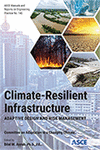Chapter 5
Flood Design Criteria
Publication: Climate-Resilient Infrastructure: Adaptive Design and Risk Management (MOP 140)
Abstract
This chapter depicts coastal flooding components and summarizes special flood hazard areas. Prior to calculating flood loading within coastal locations, the design flood event’s anticipated depth of floodwater and wave action must be determined. The design flood elevation (DFE) is used to obtain flooding depths and calculate certain flood loads based on local topography. The chapter discusses the DFE standards. DFE criteria are often developed during conceptual or predesign phases for a project and are subject to cost-benefit and sensitivity testing. The DFE should, at a minimum, conform to stakeholder requirements, industry standards, model codes, and other regulatory requirements. The DFEs are determined by applying freeboard to the base flood elevation. Per FEMA and ASCE, freeboard is a factor of safety, expressed in ft above a flood level.
Get full access to this chapter
View all available purchase options and get full access to this chapter.
5.4 References
ASCE. 2005. Flood resistant design and construction. ASCE/SEI 24. Reston, VA: ASCE.
ASCE. 2010. Minimum design loads for buildings and other structures. ASCE/SEI 7-10. Reston, VA: ASCE.
ASCE. 2014. Flood resistant design and construction. ASCE/SEI 24-14. Reston, VA: ASCE. Accessed February 13, 2016. http://ascelibrary.org/doi/book/10.1061/9780784413791.
ASCE. 2015. Adapting infrastructure and civil engineering practice to a changing climate. Accessed February 13, 2016. http://ascelibrary.org/doi/book/10.1061/9780784479193. Reston, VA: ASCE.
CEQ (Council for Environmental Quality). 2016. Final guidance for federal departments and agencies on consideration of greenhouse gas emissions and the effects of climate change in NEPA reviews. Washington, DC: CEQ.
FEMA (Federal Emergency Management Agency). 2013. Flood Insurance Study Number 360497V000B. Volume 1 of 1 (Preliminary: December 5, 2013). Washington, DC: FEMA.
FEMA. 2015. “Revised guidelines for implementing Executive Order 11988, Floodplain Management, and Executive Order 13690, Establishing a Federal Flood Risk Management Standard, and a process for further soliciting and considering stakeholder input.” Washington, DC: FEMA.
Glahn, B., A. Taylor, N. Kurkowski, and W. A. Shaffer. 2009. “The role of the SLOSH model in National Weather Service storm surge forecasting.” Nat. Weather Dig. 33(1), 3-14.
Hamlington, B. D., R. R. Leben, K.-Y. Kim, R. S. Nerem, L. P. Atkinson, and P. R. Thompson. 2015. “The effect of the El Niño-Southern Oscillation on U.S. regional and coastal sea level.” J. Geophys. Res. Oceans 120(6), 3970-3986.
IPCC (Intergovernmental Panel on Climate Change). 2013. “Summary for policymakers.” In Climate change 2013: The physical science basis, T. F. Stocker et al. (eds.). Cambridge, UK: Cambridge Univ. Press.
IPCC. 2014. Climate Change 2014: Synthesis report. Geneva, Switzerland: IPCC.
Kilgore, R. T., G. Herrmann, W. O. Thomas, and D. B. Thompson. 2016. “Highways in the river environment—Floodplains, extreme events, risk, and resilience.” No. FHWA-HIF-16-018. Washington, DC: Federal Highway Administration.
Kopp, R. E., A. Broccoli, B. Horton, D. Kreeger, R. Leichenko, J. A. Miller, et al. 2016. “Assessing New Jersey’s exposure to sea-level rise and coastal storms: Report of the New Jersey Climate Adaptation Alliance Science and Technical Advisory Panel.” Prepared for the New Jersey Climate Adaptation Alliance, New Brunswick, NJ.
NPCC (New York City Panel on Climate Change). 2015. “Building the knowledge base for climate resiliency.” Ann. N.Y. Acad. Sci. 1336(1). ISSN 0077-8923.
NOAA (National Oceanic and Atmospheric Administration). 2009. “Sea level variations of the United States.” NOAA Tech. Rep. NOS CO-OPS 053. Silver Spring, MD: NOAA.
NOAA. 2017a. Tides and currents. The Battery, NY. Station Id: 8518750 (water-level data accessed Mar. 22, 2017).
NOAA. 2017b. “Global and regional sea level rise scenarios for the United States.” W. V. Sveet et al. (eds.). NOAA Tech. Rep. NOS CO-OPS 083. Silver Spring, MD: NOAA.
USACE (US Army Corps of Engineers). 2013. “Incorporating sea level change in civil works programs.” ER 1100-2-8162. Washington, DC: USACE.
Information & Authors
Information
Published In
Climate-Resilient Infrastructure: Adaptive Design and Risk Management (MOP 140)
Pages: 133 - 148
Editor: Bilal M. Ayyub, Ph.D., P.E.
ISBN (Print): 978-0-7844-1519-1
ISBN (Online): 978-0-7844-8190-5
Copyright
© 2018 American Society of Civil Engineers.
History
Published online: Oct 3, 2018
ASCE Technical Topics:
Authors
Metrics & Citations
Metrics
Citations
Download citation
If you have the appropriate software installed, you can download article citation data to the citation manager of your choice. Simply select your manager software from the list below and click Download.
